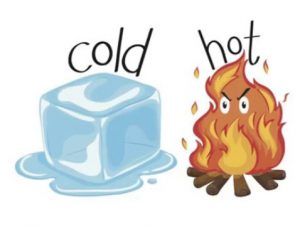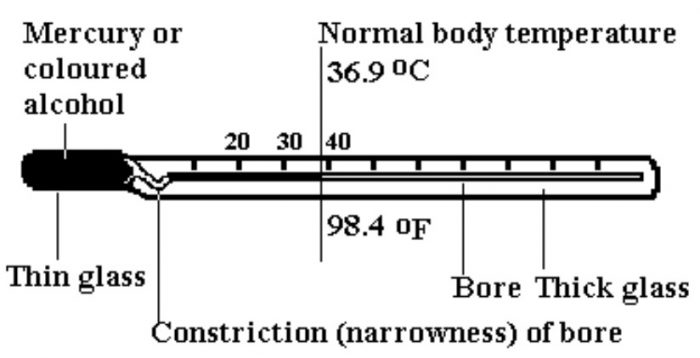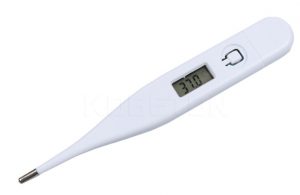Question 1 What is clinical thermometer? What is its range? Why it is not used to measure high temperature?
Question 2 What is a thermometer? Name two types of thermometers? Which type of thermometer is used to measure human body temperature?
Question 3 Why laboratory thermometer is not suitable for measuring human body temperature?
Question 4 What is the function of kink in clinical thermometer?
Question 5 Define the term temperature?
Question 6 Give the similarities and differences between clinical and laboratory thermometer?
Question 7 What are the units in which temperature is measured?
Question 8 What is the normal temperature range of laboratory thermometer?
Question 9 What is the temperature range of clinical thermometer?
Question 10 Name the liquid which is used in thermometers?
Question 11 Name the two temperature scales in clinical thermometer? What is their range?
Question 12 What precautions should be taken while using laboratory thermometer?
Question 13 What precautions should be taken while using clinical thermometer?
Question 14 What are digital thermometers?
Question 15 Explain the working of clinical thermometers?
☛ Also Read NCERT Solutions for Chapter 4 Heat
Contents
What is heat?
Heat is a form of energy. It makes a substance hotter. We can feel the heat by the temperature effect it produces. When heat is given to a substance, its temperature increases and it becomes hotter.
For example: When a utensil is kept on a gas burner, it gets heat, its temperature increases and it becomes hot. When heat is removed from a substance then its temperature decreases and it becomes cold.
Hot and Cold
Tea is hot but ice is cold, soup is hot but ice cream is cold, the spoon kept in a cup of hot milk is hot whereas fruit juice is cold, a frying pan kept on a burning gas stove is hot but the handle of frying pan is cold.
A reliable measure of the hotness (or coldness) of an object is its temperature. The temperature of an object is measured by using a device called thermometer.
Temperature
If we touch a utensil kept on a burning gas stove, it feels to be very hot. We say that the temperature of utensil is very high. If we touch a utensil placed in a refrigerator, it feels to be very cold. And we say that the temperature of utensil is very low. Thus, a hot object has a high temperature whereas a cold object has a low temperature.
The temperature of an object is the degree of hotness (or coldness) of the object.
A high temperature of an object tells us that it is very hot whereas a low temperature of the object tells us that it is quite cold.
For example: The temperature of boiling water is 100°C, which is quite high. So, boiling water feels to be very hot.
On the other hand, the temperature of melting ice is 0°C, which is quite low. So, ice feels to be very cold to touch.
Temperature is measured by using a device (or instrument) called thermometer. A thermometer has a scale marked on it which is used to read the temperature. The most common temperature scale marked on thermometers for measuring temperatures is the Celsius scale.
So, the temperature is expressed in the unit of ‘degree Celsius’ (which is written in short form as °C). In the unit °C, the small circle at the top denotes the term ‘degree’ and the letter C denotes Celsius. So, the unit C is read as ‘degree Celsius or just degree C’.
In the Celsius scale of temperature, the temperature of melting ice is given a value of 0°C (zero degree Celsius) and the temperature of boiling water is given a value of 100 °C (hundred degrees Celsius).
Measuring Temperature: Thermometers
There are two common types of thermometers:
(1) Laboratory thermometer and
(2) Clinical thermometer
The laboratory thermometer as well as clinical thermometer are mercury thermometers. When heat is supplied to the thermometer bulb containing mercury , the mercury expands and rises in the glass tube of thermometer.
Laboratory Thermometer
A laboratory thermometer is used for measuring the temperature in a science laboratory.
(1) A laboratory thermometer is made up of a long glass tube having a thin bore in it.
(2) There is a glass bulb containing mercury which is joined at the lower end of the glass tube.
(3) The top end of glass tube is sealed (after removing air)
(4) The whole length of thermometer glass tube is graduated (or calibrated) in degrees Celsius.
(5) The graduations marked on the tube of a commonly used laboratory temperatures are from, -10°C to 110°C. This is called the range of thermometer. Thus, the range of a laboratory thermometer is generally from, -10°C to 110°C.
(6) If we look at the temperature markings of say, 0°C and 10°C on the thermometer tube, we will find that there are 10 small divisions in-between them. Now, since 10 small divisions on this laboratory thermometer tube represent a temperature of 10 degrees Celsius, therefore, 1 small division on the laboratory thermometer will represent a temperature of 1 degree Celsius.
(7) There a thin silvery thread of mercury in the narrow glass tube of the thermometer. The upper end of this mercury thread (or column) tells us the temperature of the object in which the thermometer bulb is placed.
Precautions in Using a Laboratory Thermometer
(1) The laboratory thermometer should be held vertically (or upright) while measuring temperature. It should not be tilted.
(2) The thermometer bulb should be surrounded from all sides by the substance whose temperature is to be measured.
(3) The thermometer bulb should not touch the sides or bottom of the container in which the substance is taken.
(4) Read the thermometer while its bulb is still in touch with the substance whose temperature is being measured.
(5) Read the thermometer by keeping the level of mercury along the line of sight.
(6) Do not hold the thermometer by the bulb.
(7) Handle the thermometer with care. It can break if hit against any hard object.
A laboratory thermometer cannot be used to measure the human body temperature. This is because as soon as we take out the bulb of the laboratory thermometer from our mouth, the level of mercury in its tube will start falling quickly. This will give a wrong value of the body temperature. For measuring the body temperature, we should use a thermometer in which the mercury level does not fall even when its bulb is removed from the mouth.
The kink is a narrow and sharp bend (or curve) in the bore of a clinical thermometer tube. The clinical thermometer is also called Doctor’s thermometer.
Clinical Thermometer
The normal temperature of human body is 37°C . When a person gets fever, his body temperature rises. The thermometer used for measuring the temperature of human body is called clinical thermometer.
A clinical thermometer is used to measure our body temperature by a doctor (or at home).
(1) A clinical thermometer consists of a long glass tube having a thin and uniform bore.
(2) There is a glass bulb at one end of the tube. This glass bulb contains mercury.
(3) Outside the glass bulb, a small, shining thread of mercury can be seen in the thermometer tube.
(4) The other end of glass tube is sealed (after removing air). A temperature scale is marked on the glass tube of the clinical thermometer. The clinical thermometer has a temperature scale marked from 35°C to 42°C.
The clinical thermometer is a mercury thermometer which has been specially designed to measure the temperature of human body. A clinical thermometer has two special features which make it different from the laboratory thermometer.
(1) A clinical thermometer has a very short range of temperature from 35°C to 42°C .The short range of a clinical thermometer is due to the fact that the temperature of human body normally does not go below 35°C or above 42°C.
(2) A clinical thermometer has a kink (or constriction) in its glass tube just above the bulb containing mercury . The kink is to prevent the back flow of mercury into the thermometer bulb when the thermometer bulb is removed from the mouth of a patient. The kink prevents the mercury level in the thermometer tube from falling on its own. When the thermometer bulb is removed from the mouth of a patient, the mercury thread will keep standing at the maximum level reached. Due to this we can read the correct body temperature of the patient even after removing the thermometer bulb from his mouth.
Precautions in Using a Clinical Thermometer
(1) The clinical thermometer should be washed before and after use.
(2) Before using the clinical thermometer, we should ensure that the mercury level in its tube is below 35°C mark.
(3) Read the clinical thermometer by keeping the level of mercury along the line of sight.
(4) The clinical thermometer should never be held by the bulb while reading it.
(5) Handle the clinical thermometer with care. The thermometer can break if it hits against some hard object.
The scale marked on the clinical thermometer tube, we will find that the temperature difference indicated by the two big marks (say, 37°C and 38°C) is 1 degree.
There are 10 small divisions between the 1 degree temperature. Since 10 small divisionsobject represent 1 degree C temperature, therefore, 1 small division represents 1/10 degree C temperature or 0.1 degree C temperature.
With a clinical thermometer, we can measure the human body temperature accurately up to one-tenth of a degree.
A clinical thermometer has usually two temperature scales marked on its glass tube on the two sides of the mercury thread: Celsius scale of temperature and Fahrenheit scale of temperature.
The scale of temperature marked on the clinical thermometer has a range of 94°F to 108°F.
The normal temperature of human body on Fahrenheit scale is 98.6 °F.
Working of a Clinical Thermometer
When we put the thermometer bulb in the mouth of a patient, then some of the body heat of patient is transferred to the mercury in the thermometer bulb. This heat makes the liquid mercury of the thermometer bulb to expand (increase in volume) due to which the mercury thread is pushed to a higher level in the thermometer tube. Higher the fever of a patient, greater will be his body heat and hence higher will be the level of mercury or higher will be the temperature shown by the thermometer.
A clinical thermometer cannot be used to measure high temperatures because it has been designed to measure only human body temperature which varies over a short range. If a clinical thermometer is used to measure high temperatures, it will get damaged.
For example: we should not measure the temperature of hot milk by using a clinical thermometer. This is because the temperature of hot milk is very high due to which it will cause a large expansion of mercury. And since there is no extra space in the glass tube of clinical thermometer to accommodate large expansion of mercury, the thermometer tube will break.
Comparison Between Clinical Thermometer and Laboratory Thermometer
A similarity between clinical thermometer and laboratory thermometer is that both are mercury-in glass thermometers.
The differences between a clinical thermometer and a laboratory thermometer are as follows:
(1)The clinical thermometer has a very short temperature range (35°C to 42°C) whereas a laboratory thermometer has a large temperature range (usually from, -10°C to 110°C)
(2) The clinical thermometer has a kink (or constriction) in its tube to prevent the back flow of mercury into the bulb whereas a laboratory thermometer has no kink.
(3) The clinical thermometer measures temperature more accurately (up to 0.1°C) than a laboratory thermometer (which usually measure up to 1°C)
Digital Thermometers
Most of the common thermometers are mercury thermometers which use a liquid metal called mercury for their working. Mercury is a toxic substance (poisonous substance) and hence it is very difficult to dispose of safely if a thermometer breaks.These days, digital thermometers are available which do not use mercury .
There is a special thermometer called maximum-and-minimum thermometer which automatically records the maximum and minimum temperatures of the day. The maximum and minimum temperature of the previous day reported in weather reports in TV and newspapers are measured by the maximum-and minimum thermometer.




Leave a Reply